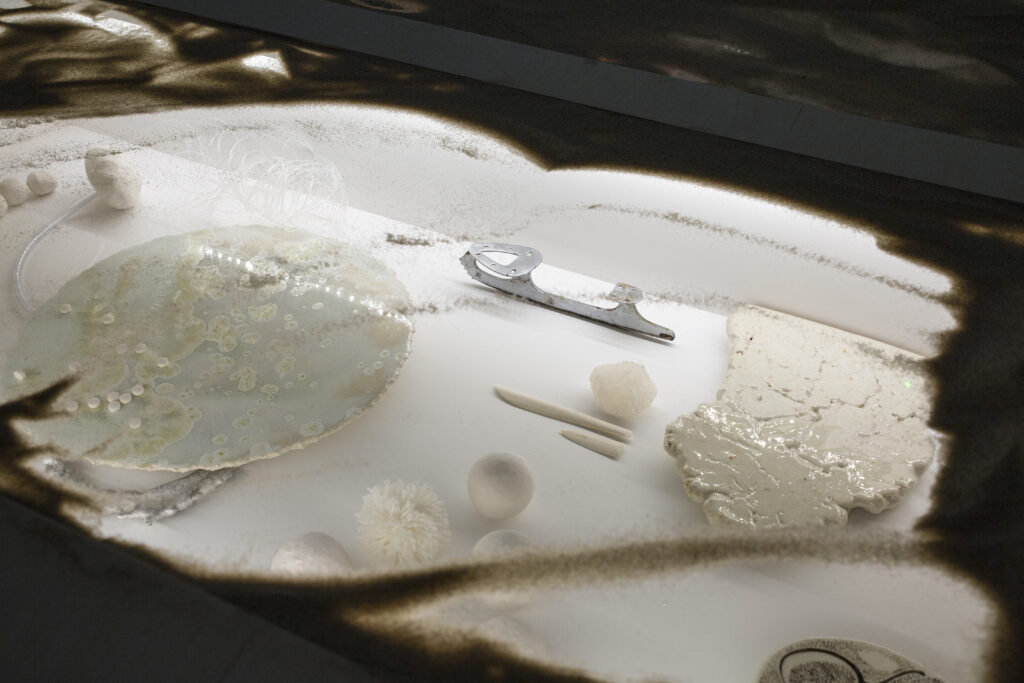
Ingrid Allik (1958) is a ceramicist, whose versatile work combines autobiographical elements with nature inspired forms. She is one of the most notable experts of the Japanese raku technique in Estonia. Allik experiments with various clays, glazing, and firing techniques, mixing ceramic items with found objects. In her installations, Allik uses a variety of materials, all equally valuable to her. Depending on the context, she highlights harmony between individual pieces and their meanings.
Inspired by Japanese culture, Allik mixes ceramics and ikebana, an art in which she was trained at the end of the 1970s by Dagmar Kotli and at the beginning of the 1980s through distance learning by Noriko Ono, the head of Kokusai Ikebana International. Due to travel restrictions in the Soviet Union, the process was conducted via mail. One of Allik’s ikebana-influenced compositions was exhibited at the group show “Hortus Ceramicus“ (with Viive Väljaots, Kersti Laanmaa, Tiina Kaljuste and Kaie Pungas; 2008 in Vilnius, 2009 at Hop gallery and the Museum of New Art in Pärnu) and solo exhibition “Hea ilm“ (Good weather, 2012), where she combined utilitarian vase-like forms and plants, creating untraditional ikebana compositions.
At the exhibition “Kahel pool vett” (On two sides of water, 2016, with Riitta Talonpoika) at Hop gallery Allik exhibited works resembling Alexander Calder’s mobile sculptures, inspired by movement of water – its lightness, floating and dissolving nature. The luminous porcelain compositions created an illusion of the depths of the sea, its organisms and creatures, hung from the ceiling in the gallery space.
At the exhibition “How to: live. Virtual biographies” (2018, with Dre Britton and Laura Põld, curated by Marika Agu) at the Contemporary Art Museum of Estonia Allik exhibited works inspired by her personal life and domestic space. The three artists proposed tools that a space could be made up of, allowing viewers to reconstruct ways of living, imaginary or real human activities and biographies.
The solo exhibition “Sekret/Cekpet. A hide and seek of memories” (2020) at the Estonian Museum of Applied Art and Design grew out of a childhood game, exposing the desire to both hide and display one’s “treasures”. At the exhibition Allik showcased ceramic objects and personal items she had collected over several decades. In order to look at the objects the visitors had to wipe away the sand on the display case, creating grooves and piles between the visible and invisible.
In the exhibition “Like stones in flowing water” (2020, with Tiiu-Pallo Vaik and Naima Neidre, curated by Tamara Luuk) at City Gallery, Allik combined nature-inspired ceramic forms with found objects, referring to the relationship between nature and humans, where nature always prevails. The show was searching for a common mood in the work of the three artists, inspired by stillness, stability but also shift and flow.
Ingrid Allik graduated from the ceramics department of the Estonian State Art Institute (BA, 1981; MA, 2004). Since 1987 she has worked at the ceramics department in the Estonian Academy of Arts. Allik was among the first Estonian ceramicists to use the Japanese raku technique in her work. In 2010 she published the handbook “Raku. Kujunemine ja kogemus” (Raku. Development and Experience). Allik has received the title of Ceramic Artist of the Year (2010), Creativity Award of the Estonian Academy of Arts (2019) and Estonian Cultural Endowment’s annual award (2020). Her works belong to the collections of the Estonian Museum of Applied Art and Design, Estonian History Museum and Tallinn City Museum as well as in private collections in Latvia, Lithuania, Denmark, USA, Germany and Japan.